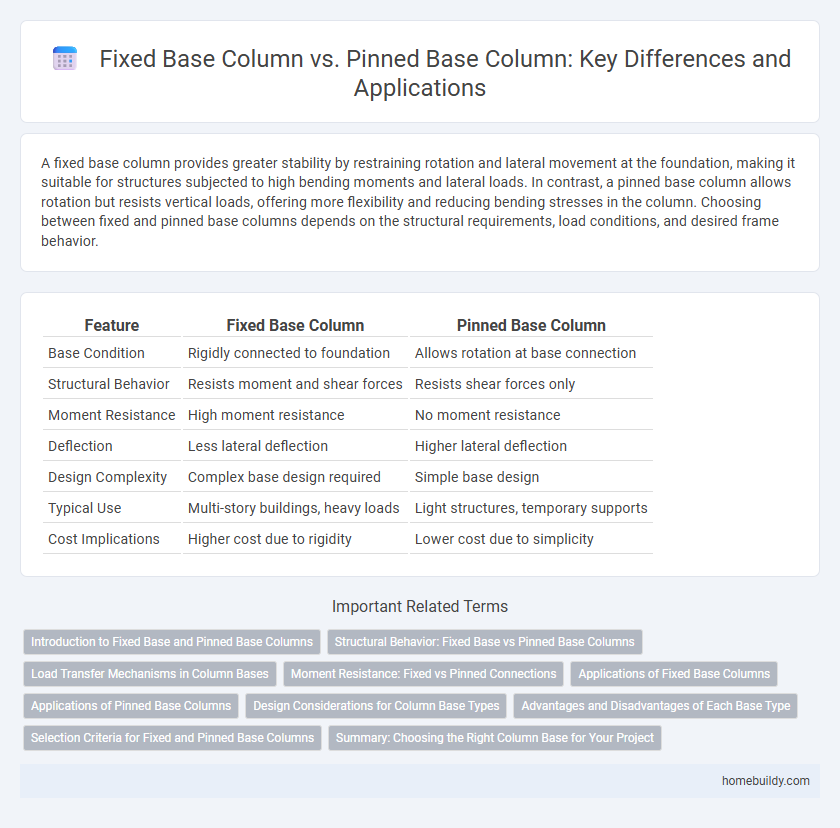A fixed base column provides greater stability by restraining rotation and lateral movement at the foundation, making it suitable for structures subjected to high bending moments and lateral loads. In contrast, a pinned base column allows rotation but resists vertical loads, offering more flexibility and reducing bending stresses in the column. Choosing between fixed and pinned base columns depends on the structural requirements, load conditions, and desired frame behavior.
Table of Comparison
| Feature | Fixed Base Column | Pinned Base Column |
|---|---|---|
| Base Condition | Rigidly connected to foundation | Allows rotation at base connection |
| Structural Behavior | Resists moment and shear forces | Resists shear forces only |
| Moment Resistance | High moment resistance | No moment resistance |
| Deflection | Less lateral deflection | Higher lateral deflection |
| Design Complexity | Complex base design required | Simple base design |
| Typical Use | Multi-story buildings, heavy loads | Light structures, temporary supports |
| Cost Implications | Higher cost due to rigidity | Lower cost due to simplicity |
Introduction to Fixed Base and Pinned Base Columns
Fixed base columns are structural elements rigidly connected to the foundation, providing high moment resistance and stability under lateral loads. Pinned base columns are connected with a hinge allowing rotation at the base, offering minimal moment resistance and primarily transferring axial loads. Understanding the differences in base conditions is crucial for accurate structural analysis and design of columns under various loading scenarios.
Structural Behavior: Fixed Base vs Pinned Base Columns
Fixed base columns exhibit higher moment resistance due to restrained rotation at the base, enhancing structural stability and reducing lateral displacements under loads. Pinned base columns allow rotational freedom, resulting in lower moment capacity and increased susceptibility to buckling under axial and lateral forces. The choice between fixed and pinned bases significantly impacts load distribution, deflection characteristics, and overall column performance in structural systems.
Load Transfer Mechanisms in Column Bases
Fixed base columns transfer loads through rigid moment connections, effectively resisting bending moments, shear forces, and axial loads by fixing the column base to the foundation. Pinned base columns primarily transfer loads as axial forces and shear, allowing rotation at the base, which reduces bending moments but requires additional bracing to handle lateral loads. The load transfer mechanism in fixed bases provides higher structural stability, whereas pinned bases offer flexibility but rely heavily on load distribution through column members and connections.
Moment Resistance: Fixed vs Pinned Connections
Fixed base columns provide higher moment resistance due to the rigid connection at the foundation, effectively transferring bending moments and shear forces between the column and base. Pinned base columns have negligible moment resistance as the connection allows rotation, making them primarily designed to resist axial loads while relying on bracing or additional supports for lateral stability. The choice between fixed and pinned base columns significantly impacts structural behavior, load distribution, and overall moment capacity in steel and concrete frame designs.
Applications of Fixed Base Columns
Fixed base columns provide superior structural stability by resisting moments and shear forces, making them ideal for high-rise buildings, bridges, and industrial structures requiring minimal lateral displacement. Their rigid connection to the foundation allows for better load distribution and increased stiffness compared to pinned base columns, which only resist axial loads. Common applications include skyscrapers, heavy machinery supports, and seismic-resistant structures where fixed base columns enhance overall durability and safety.
Applications of Pinned Base Columns
Pinned base columns are widely used in structures where rotational flexibility at the base is essential to accommodate lateral forces without inducing significant moments. Common applications include bridges, industrial frames, and lightweight steel structures where the base connection must allow rotation to prevent excessive stress concentrations. This design approach enhances seismic performance by allowing controlled movement and reducing the risk of structural failure during dynamic loading.
Design Considerations for Column Base Types
Design considerations for fixed base columns emphasize rigidity and moment resistance, ensuring the base can sustain bending forces and provide structural stability in lateral loads. Pinned base columns prioritize rotational freedom at the base, allowing the structure to accommodate movements and reduce moment transfer, which is ideal for foundations sensitive to settlement. Structural engineers assess load conditions, foundation behavior, and moment demands to select between fixed and pinned bases, optimizing safety and performance.
Advantages and Disadvantages of Each Base Type
Fixed base columns provide enhanced stability and resistance to lateral forces by rigidly connecting to the foundation, making them ideal for structures subjected to high wind or seismic loads. However, they are more complex and costly to design and construct, requiring precise alignment and detailed reinforcement. Pinned base columns allow rotation and accommodate slight settlement, reducing moments transferred to the foundation and simplifying construction, but they offer less lateral stiffness and may lead to increased deflections in tall or heavily loaded structures.
Selection Criteria for Fixed and Pinned Base Columns
Selection criteria for fixed base columns prioritize moments of resistance and lateral stability in structures subjected to bending and shear forces, making them ideal for frames requiring rigidity. Pinned base columns are selected where rotational freedom is acceptable or desired, focusing primarily on axial load capacity and simplifying foundation design. The choice depends on structural requirements, load conditions, and the desired degree of fixity at the column base for optimal performance.
Summary: Choosing the Right Column Base for Your Project
Fixed base columns provide enhanced structural stability by resisting moments and shear forces, making them ideal for heavy load-bearing applications in construction. Pinned base columns allow rotational movement, reducing moment transfer to the foundation and are suitable for structures where flexibility under lateral loads is needed. Selecting the appropriate column base depends on load requirements, foundation design, and the desired structural behavior to ensure optimal safety and performance.
fixed base column vs pinned base column Infographic

 homebuildy.com
homebuildy.com